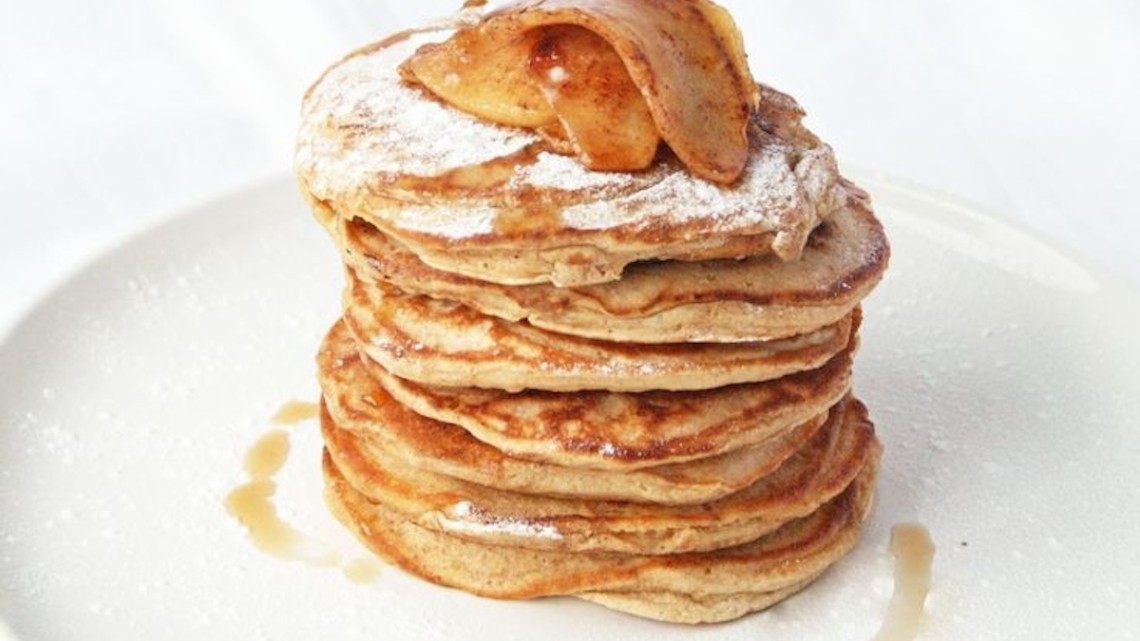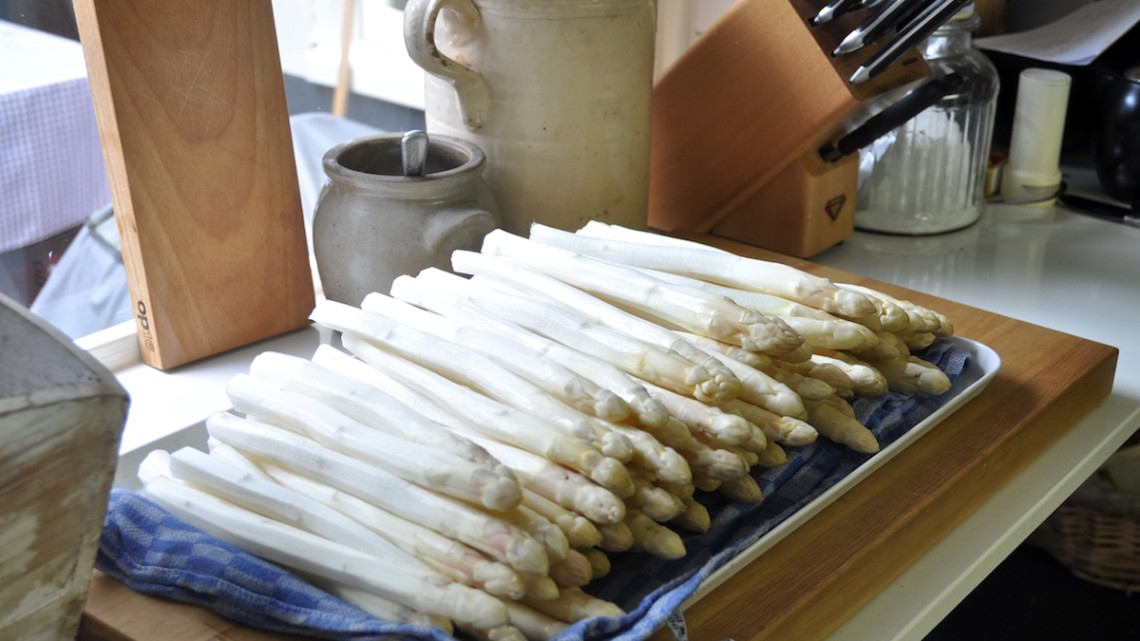Artichokes Barigoule
Serves 4-6 as a side dish
Ingredients
12 small violet artichokes
1 lemon
100 ml olive oil
1 small onion, chopped
1 small carrot chopped
2 tomatoes, chopped
1 teaspoon cumin seeds, toasted
3 pieces of orange peel
2 fresh bay leaves
2 sprigs of thyme
1 teaspoon fennel seeds
3 cloves of garlic, roughly chopped
200 ml white wine
small bunch of basil leaves, picked and torn
100 ml chicken or vegetable stock stock
selection of fresh herbs: chervil, fennel, basil
salt and pepper
Method
With a small knife, trim the hard leaves off the artichokes, remove the centre hairs and rub the artichokes with lemon juice.
Heat the oil in a deep casserole and fry the onions and the carrot until soft but not coloured. Stir in the tomatoes, orange peel, herbs and spices. Add the artichokes.
Pour in the wine and add enough water to cover the artichokes halfway, sprinkle over the torn basil and cover the pan with a lid. Cook slowly until tender, 35 to 45 minutes, depending on the size of the artichokes.
Remove the artichokes from the pan, reduce the cooking juices and add a little chicken or vegetable stock to intensify the flavour. Season with salt and pepper and finish off with fresh herbs.
We, the Amsterdam Flavours chefs, hope you enjoy this recipe as much as we do. If you have any questions on how to prepare it or just want to send us your feedback, you can reach us here Contact Amsterdam Flavours
Apple Pancakes
Serves 4
Ingredients
for the pancakes
¾ cup milk (about 200 ml)
1½ tablespoons vinegar
1 cup flour
3 tablespoons sugar
1 teaspoon cinnamon
1 teaspoon baking powder
½ teaspoon bicarbonate of soda
½ teaspoon salt
1 egg
2 tablespoons oil
caramelized apples
2 tablespoon butter
2 apples, peeled, cored, and thinly sliced
2 tablespoons brown sugar
½ teaspoon cinnamon
⅓ cup maple syrup
Method
Whisk together the milk and vinegar and allow to rest for 5 minutes.
While the milk is curdling (the milk will literally start to separate. Don't be alarmed, this is supposed to happen!), whisk together the flour, sugar, baking powder, bicarbonate of soda and salt in a large bowl. Whisk egg and oil into milk. Add the wet ingredients to dry ingredients and stir until combined (don't over-mix, it should still have some lumps).
Heat a non-stick frying pan over medium heat and grease with some sunflower oil. Pour large spoonfuls of the batter into the pan. Cook about 2 minutes until bubbles form and the edges start to look "dry". Use a spatula to flip the pancakes and cook another 1-2 minutes on the other side. Set the pancakes aside and repeat with remaining batter.
Using the same pan, add the butter, apples, brown sugar and cinnamon. Stir over medium heat 3-5 minutes until apples are tender. Add the maple syrup. Serve the apples over the warm pancakes.
We, the Amsterdam Flavours chefs, hope you enjoy this recipe as much as we do. If you have any questions on how to prepare it or just want to send us your feedback, you can reach us here Contact Amsterdam Flavours
Melksalon
From 1 to 30 april this year something new is taking place in Amsterdam. The pop up Melksalon (Milk Shop) opens its doors! This temporary pilot and design store brings consumers, dairy farmers, dairy processors, designers and scientists together to rediscover the value of milk. There will be lectures, organized design sessions, movie nights and city walks. Chefs will also provide a series of special dinners. At the same time the Melksalon is a store and milk bar where you can walk in and taste different kinds of milk.
History and background
On 1 april, the European milk quota, which restricts the amount of milk that dairy farmers can produce was lifted. The Melksalon pop-up store also facilitates, at the perfect moment, a dialogue as to the relevance of milk in today's modern society.
Around 1900 many milk parlours were found on the streets of Amsterdam, where the city's inhabitants enjoyed a glass of milk from local farmers. Nowadays, we buy milk from the supermarket, but milk has always played an important role in Dutch history, (food) culture, the economy, innovation and the landscape. Yet, few realise the rich influence milk has had. Milk in the supermarket is often an anonymous bulk product. At the same time, there is a strong public debate going on about the consumption of milk, the influence on the environment and landscape, and the price one pays.
We enjoyed a tasting of 4 different milks, each with their own flavour, sweetness and richness. We also tried the steamed buns, made using a milk-based dough, the one filled with a braised Asian beef and the other with sweet peas.
A great new addition to Amsterdam. Go and visit while it still lasts.
For more information, please visit Melksalon.
Sausages Rolls
Ingredients
500 g sausage mince
1 egg
1 cup fresh breadcrumbs or panko
40 ml Worcestershire sauce
1 tablespoon tomato paste
sea salt and cracked black pepper
250g puff pastry
1 egg yolk, lightly beaten
sesame seeds to sprinkle
Method
Preheat the oven to 200°C. Combine the mince, eggs, breadcrumbs, Worcestershire sauce, tomato paste, salt and pepper. Roll out the pastry to 3 mm thick and cut into 12cm x 24 cm pieces or cut each ready-rolled pastry sheet in half.
Divide the sausage mixture into six equal portions, roll into sausage shapes and place down the centre of each piece of pastry. Roll to enclose, placing the pastry seam underneath.Cut the sausage rolls into thirds and place on a baking tray lined with non-stick baking paper. Brush with the egg yolk and sprinkle with sesame seeds.
Bake for 20–25 minutes or until golden and cooked through.
We, the Amsterdam Flavours chefs, hope you enjoy this recipe as much as we do. If you have any questions on how to prepare it or just want to send us your feedback, you can reach us here Contact Amsterdam Flavours
Asparagus
Asparagus season has officially started for this year! And we're so pleased, as asparagus are one of our favourite vegetables. They're incredibly versatile as they can be blanched, grilled, roasted and when thinly shaved, even served raw.
How do you best store and clean asparagus?
In the refrigerator asparagus have a shelf life of about 7 days, in a damp tea towel (to prevent drying out) it's 1 to 3 days. Asparagus can also be frozen. Before freezing, the asparagus should be washed and peeled (there is no need to blanche them). When you want to use the asparagus, place them straight from the freezer into a pan of boiling water.
To give you some inspiration, here are 2 of our recipes using asparagus. Go out and get some now!
Asparagus and Turnip Greens Pasta
De Weldaad
De Weldaad has two shops in the historic centre of Amsterdam, one in the Reestraat (opposite Hotel Pulitzer on the corner of Keizersgracht, very close to the Anne Frank Museum) and one at de Noordermarkt (the Northern Market) near the Westerstraat in an area called the Jordaan. If you are looking for vintage, art nouveau, industrial design, antiques or brocante, you will most probably find it at De Weldaad.
The charming Reestraat shop has an original interior from the 19th century and is located in the heart of the capital, in a shopping area known as the Nine Streets (negenstraatjes). You will find special and unique shops around here selling items such as paper, candles, gourmet gifts. There is even a real doll doctor! In short, a really fun shopping paradise.
The second store is situated at the Noordermarkt (Northern Market) in the heart of the Jordaan in Amsterdam. It's a former garage covering 200 m2. Three historic buildings are interconnected with plenty of room to explore the furniture, lifestyle products and unique accessories for the home from all over Europe.
We both have furniture and accessories from De Weldaad in our own homes. It's a style that suits us both and is easily combined with more modern items to create the look and feel you want.
For more information, please visit De Weldaad.
Chicken Tikka Masala
This is one of our favourite 'Indian' dishes. It's easy to make with readily available ingredients and it's always a crowd pleaser. We say Indian in inverted commas, as it's origins are not quite known. It's thought that it originated in Glasgow in the 1970's. The story goes: "On a typical dark, wet Glasgow night a bus driver coming off shift came in to the Shish Mahal restaurant and ordered a chicken curry. He sent it back to the waiter saying it was dry. At the time the owner had an ulcer and was enjoying a plate of tomato soup. So he said to the chefs why not put some tomato soup into the curry with some spices. It was sent back to the table and the bus driver absolutely loved it. He and his friends came back again and again and since then it was put on the menu."
Serves 4
Ingredients
sunflower oil
2 large onions, peeled and sliced
1 red or green chilli
5 cm piece fresh ginger, peeled
2 garlic cloves, peeled
1/2 teaspoon chilli powder
1 teaspoon turmeric
2 teaspoons garam masala
1 tablespoon brown sugar
1 small tin tomato puree
2 tins peeled tomatoes
1 kg boned and skinned chicken thighs, cut into cubes
10 curry leaves (optional)
4-6 tablespoons natural yoghurt
bunch fresh coriander, chopped
steamed rice, naan bread and poppadums, to serve
Method
Finely slice the onion. Heat 2 tablespoons sunflower oil in a pan. Add the onions and fry on a medium-low heat for a good 15-20 minutes until they become soft and caramelised. In the meantime, deseed and chop the chilli, ginger and garlic. Add to the pan with the onions and fry for a further 2 minutes.
Add the chilli powder, turmeric, garam masala and sugar to the onions and fry for 1-2 minutes. Add the the tomato puree and fry for a further 1-2 minutes. Add the tinned tomatoes and simmer for about 10 minutes. Place the sauce in a bowl or a jug and blend with a Bamix (stick blender) until smooth.
Add 1 tablespoon sunflower oil to the same pan you cooked the sauce in and fry the chicken pieces until lightly coloured, about 5 minutes. Pour in the blended sauce and curry leaves, if using, and some salt and simmer, covered, for about 20 minutes until the chicken in cooked through and tender.
Stir the yoghurt and half the coriander through the tikka masala. Garnish with the remaining coriander and serve with steamed rice, naan breads and/or poppadums.
We, the Amsterdam Flavours chefs, hope you enjoy this recipe as much as we do. If you have any questions on how to prepare it or just want to send us your feedback, you can reach us here Contact Amsterdam Flavours
Baden Baden Interior & Mud Australia
It is with great pride that we welcome a new partner to Amsterdam Flavours. Baden Baden Interior is an interior design store in Amsterdam offering an eclectic mix of furniture, design, art, objects and accessories.
Baden Baden Interior is the main importer and supplier of Mud Australia porcelain. When searching for a new range of plates for our food photography and styling, we came across and instantly fell in love with the Mud Australia range because of their natural, unique shapes and beautiful colours. After doing some research, we found our way to Baden Baden Interior.
Mud Australia was founded in 1994. The porcelain range, designed by Shelley Simpson, combines hand made processes, clean lines, colour palette and functionality. The end result is a product that neatly intersects a minimalist aesthetic with an artisan finish. Their porcelain fits in any interior, providing a timeless alternative to mass produced ceramic design.
All Mud Australia porcelain is handmade in their Sydney factory by a staff of professional and in-house ceramicists. Each piece is designed to last and manufactured using the best materials available.
Made from Limoges porcelain, sourced directly from France, the pigment is tinted through the porcelain body to provide colour-depth. Clear glaze is then hand brushed to the interior of each piece leaving the exterior with a vitrified stone-like surface that becomes smooth with handling.
The range evolves seasonally with the addition of new shapes and colours.
For more information, please visit Baden Baden Interior and Mud Australia.
Morgan & Mees
Morgan & Mees is a brand new hotel and restaurant situated in a completely renovated historical building in Amsterdam West. The interior matches the characteristics of the monumental building, but with a modern twist. With an elegant timeless look and an eye for detail Morgan & Mees is a stylised hotel for international travellers and locals.
The bar, restaurant and hotel are tastefully designed, classical, yet modern at the same time.
The restaurant menu is brasserie inspired with very accessible dishes. In the evenings, the bar is really popular and even standing space is hard to find.
In the short time they've been open, Morgan & Mees has gained quite a following and they are certainly a valuable addition to the area.
For more information, please visit Morgan & Mees.
Amsterdam Chocolate Festival
This past weekend we paid a visit to The Amsterdam Chocolate Festival. The festival documented an array of chocolates made using cocoa from around the world.
Products, for example soaps, made using cocoa butter, were also on show. There are so many different chocolates available at the moment and this gives one the opportunity to be able taste and understand the differences and nuances that can be found in chocolates from different countries.
What is chocolate and how is it made?
Chocolate is a typically sweet, usually brown, food preparation of Theobroma cacao seeds, roasted and ground, often flavored, as with vanilla. It is made in the form of a liquid, paste or in a block or used as a flavouring ingredient in other sweet foods. Cacao has been cultivated by many cultures for at least three millennia in Mesoamerica. The earliest evidence of use traces to the Mokaya (Mexico and Guatemala), with evidence of chocolate beverages dating back to 1900 BC. In fact, the majority of Mesoamerican people made chocolate beverages, including the Maya and Aztecs, who made it into a beverage known as xocolātl, a Nahuatl word meaning "bitter water". The seeds of the cacao tree have an intense bitter taste and must be fermented to develop the flavour.
After fermentation, the beans are dried, cleaned, and roasted. The shell is removed to produce cacao nibs, which are then ground to cocoa mass, pure chocolate in rough form. Because the cocoa mass is usually liquefied before being molded with or without other ingredients, it is called chocolate liquor. The liquor also may be processed into two components: cocoa solids and cocoa butter. Unsweetened baking chocolate (bitter chocolate) contains primarily cocoa solids and cocoa butter in varying proportions. Much of the chocolate consumed today is in the form of sweet chocolate, a combination of cocoa solids, cocoa butter or other fat, and sugar. Milk chocolate is sweet chocolate that additionally contains milk powder or condensed milk. White chocolate contains cocoa butter, sugar, and milk but no cocoa solids.
For more information on the festival visit Amsterdam Chocolate Festival.
A great magazine available for the coffee and chocolate industry is Koffietcoao.







